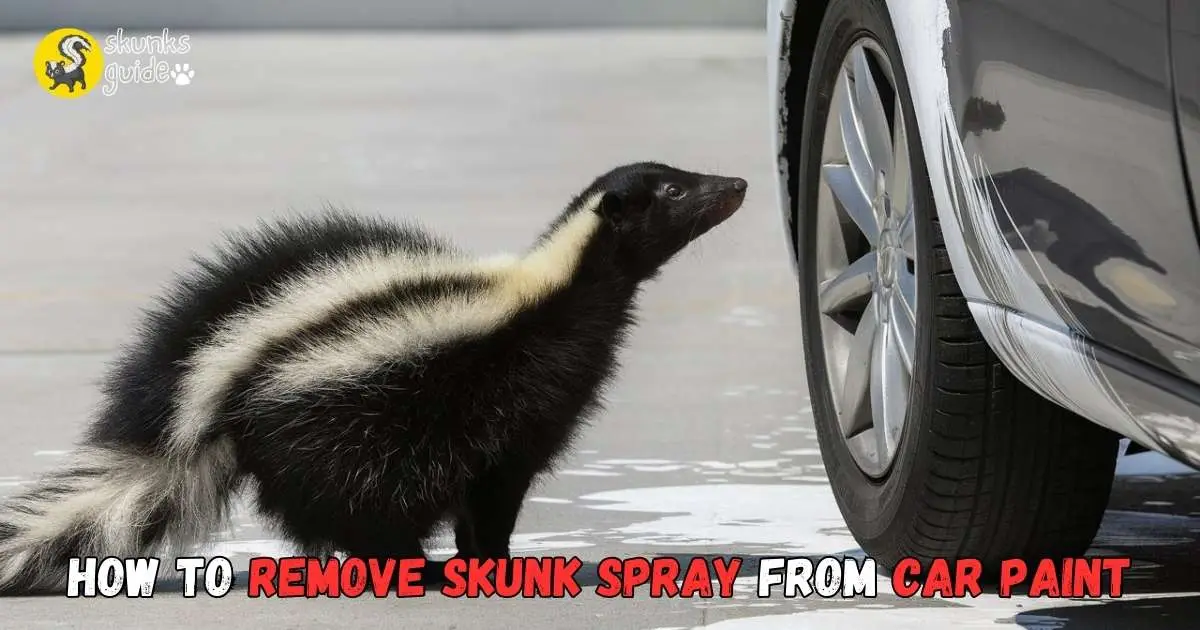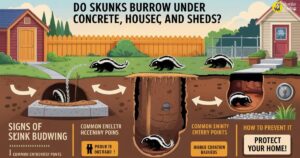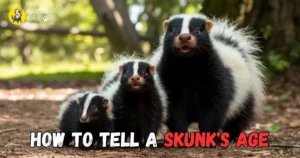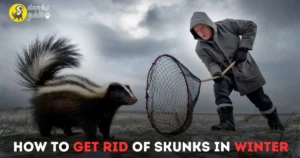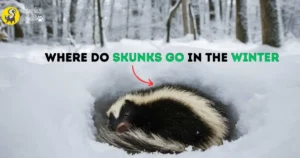How to Remove Skunk Spray from Car
If skunk spray has hit your car, don’t panic! To remove skunk spray from car paint, just mix hydrogen peroxide, baking soda, and dish soap, and you’re good to go. From my experience as a skunk researcher, I know how challenging it can be to deal with skunk spray. Let me show you the step-by-step process to make sure your car stays clean and smelling fresh.
Introduction To Skunk Spray Challenges
Getting skunk spray on your car is a real hassle. The strong odor clings to surfaces. It can damage paint if not treated quickly. Understanding the chemistry helps in tackling this challenge.
The Chemistry Of Skunk Spray
Skunk spray contains thiols and thioacetates. These compounds create a pungent smell. They can stick to surfaces and are hard to remove. Here’s a breakdown:
| Compound | Description |
|---|---|
| Thiols | Responsible for the strong odor. |
| Thioacetates | Can turn into thiols when exposed to moisture. |
These compounds react with paint and can cause damage. Prompt action is crucial for preserving your car’s finish.
Immediate Actions After Spraying
Act quickly to minimize damage. Here’s a step-by-step guide:
- Move the car to a well-ventilated area.
- Wear gloves and a mask to protect yourself.
- Rinse the affected area with water.
- Use a mixture of baking soda and dish soap.
- Scrub gently with a soft cloth or sponge.
- Rinse thoroughly with water.
- Repeat if necessary.
Follow these steps to reduce the odor and protect your paint.
- Do not use harsh chemicals.
- Avoid scrubbing too hard.
- Check for any remaining odor after cleaning.
Taking quick action helps safeguard your car’s appearance.
Safety Precautions Before Cleaning
Cleaning skunk spray from car paint requires careful planning. Follow these safety precautions to protect yourself and your vehicle. Proper preparation ensures effective cleaning and avoids damage.
Protective Gear
Wearing the right protective gear is crucial. Here are some recommended items:
- Gloves: Use rubber gloves to protect your hands.
- Mask: A mask prevents inhaling fumes from cleaning agents.
- Goggles: Protect your eyes from splashes.
- Old Clothes: Wear clothes you don’t mind staining.
Avoiding Further Damage
Taking care during cleaning helps avoid additional damage. Follow these tips:
- Test First: Always test cleaning products on a small area.
- Gentle Products: Use gentle cleaners to avoid paint damage.
- Soft Cloths: Use microfiber cloths for cleaning. They are less abrasive.
- Don’t Scrub Hard: Rubbing too hard can scratch the paint.
Following these precautions ensures a safer and more effective cleaning experience.
Pre-cleaning Steps
Removing skunk spray from car paint requires careful preparation. Follow these pre-cleaning steps to ensure effective removal.
Assessing The Affected Area
Start by examining the area where skunk spray landed. Look for these signs:
- Visible stains on the paint
- Strong odor of skunk
- Damage to the clear coat
Use your nose and eyes to confirm the extent of the spray. Mark the affected area for easy reference during cleaning.
Initial Rinse Techniques
Before using any cleaning agents, perform an initial rinse. This helps remove some of the spray. Follow these steps:
- Grab a hose or bucket of water.
- Rinse the area gently to remove excess residue.
- Avoid scrubbing to prevent damage to the paint.
Consider using a spray nozzle for better control. Aim for low pressure to avoid pushing the spray deeper into the paint.
Home Remedies For Skunk Odor Removal
Removing skunk spray from car paint can be a challenge. Home remedies offer effective and simple solutions. These methods use common household items. They help eliminate the unpleasant odor without damaging your car’s finish.

Diy Cleaning Solutions
Try these DIY cleaning solutions to tackle skunk spray:
- Baking Soda Paste: Mix 1 cup of baking soda with water. Apply the paste to the affected area. Let it sit for 10 minutes, then rinse.
- Vinegar and Water: Mix equal parts vinegar and water. Spray it on the car paint. Wipe with a clean cloth.
- Dawn Dish Soap: Combine 1 tablespoon of Dawn dish soap with 2 cups of water. Use a sponge to scrub the area gently.
Natural Deodorizers
Natural deodorizers can help neutralize the odor:
| Deodorizer | How to Use |
|---|---|
| Coffee Grounds | Place coffee grounds in a bowl inside the car. Leave for a few hours. |
| Activated Charcoal | Put activated charcoal in a container. Leave it in the car for a few days. |
| Lemon Juice | Mix lemon juice with water. Spray on affected areas and wipe clean. |
These remedies are easy to find and use. They can effectively reduce the skunk odor. Keep your car smelling fresh again.
Commercial Cleaners That Work
Removing skunk spray from car paint can be tough. Commercial cleaners provide effective solutions. They are specially designed to break down the oils and odors from skunk spray.
Choosing The Right Product
Selecting the right cleaner is crucial. Look for products that are:
- Enzyme-based: These break down the odor molecules.
- Odor neutralizers: They help eliminate the smell.
- pH-balanced: Safe for car paint and finishes.
Popular commercial cleaners include:
| Product Name | Type | Features |
|---|---|---|
| Nature’s Miracle | Enzyme Cleaner | Safe for pets, effective on odors |
| Skunk Off | Odor Neutralizer | Fast acting, non-toxic |
| Simple Green | All-Purpose Cleaner | Biodegradable, safe for many surfaces |
Application Tips For Best Results
Follow these steps for effective cleaning:
- Wear gloves and a mask for protection.
- Test the product on a small area first.
- Apply the cleaner generously to the affected area.
- Let it sit for 10-15 minutes for maximum effect.
- Gently scrub with a soft cloth or sponge.
- Rinse with clean water thoroughly.
Repeat if necessary. This ensures complete removal of the skunk spray.
Step-by-step Cleaning Process
Removing skunk spray from car paint requires careful steps. Follow this guide for effective cleaning. The right methods will ensure no damage to your car’s finish.
Gentle Scrubbing Methods
Start with the right tools. Use soft sponges and cloths. Avoid abrasive materials that can scratch the paint.
- Gather Supplies:
- Soft sponge or microfiber cloth
- Car wash soap
- Water
- White vinegar
- Baking soda
Mix a solution of water and car wash soap. Use a 1:1 ratio. For extra strength, add vinegar and baking soda.
- Soak the sponge in the solution.
- Gently scrub the affected areas.
- Use circular motions to lift the spray.
Rinse the sponge often. This prevents spreading the odor.
Rinsing And Repeating
After scrubbing, rinse the area thoroughly. Use clean water to wash away the cleaning solution. Ensure all residue is removed.
Check for any lingering odor. If it remains, repeat the scrubbing process. Patience is key.
For stubborn spots, a paste of baking soda and water can help. Apply the paste directly. Let it sit for a few minutes before scrubbing again.
Always finish by rinsing well. This ensures no product is left behind. Dry the area with a soft towel to prevent water spots.
Post-cleaning Care
After removing skunk spray from your car’s paint, proper care is essential. This ensures lasting protection and maintains the car’s appearance. Here are two key areas to focus on: waxing and long-term paint maintenance.
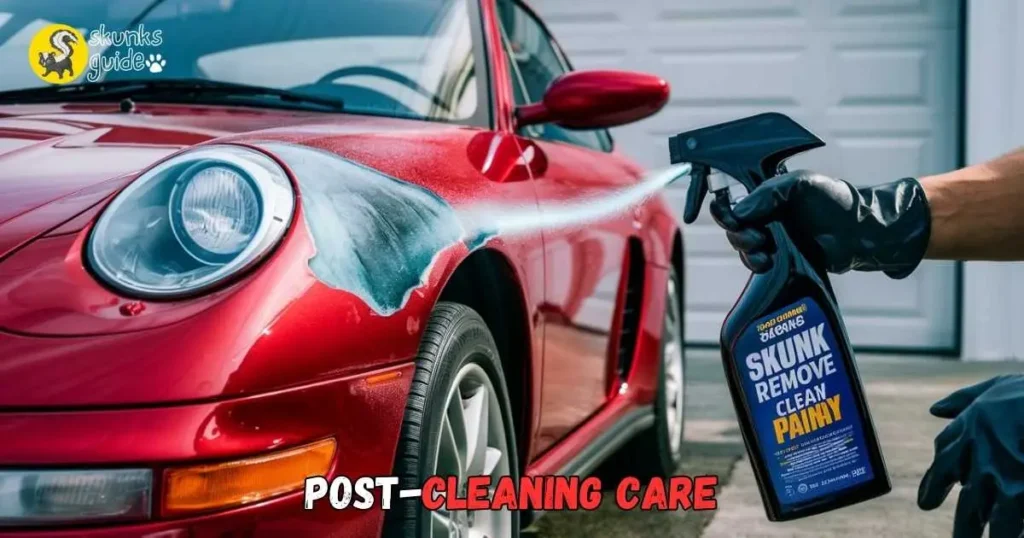
Waxing After De-skunking
Waxing is crucial after cleaning. It forms a protective layer on the paint. This layer helps prevent future damage.
- Choose a quality car wax.
- Apply wax in a shaded area.
- Use a soft cloth or applicator pad.
Follow these steps for effective waxing:
- Clean the car surface thoroughly.
- Let the paint dry completely.
- Apply a thin layer of wax.
- Buff the wax with a microfiber cloth.
Repeat waxing every three months for best results.
Long-term Paint Maintenance
Maintaining your car’s paint protects it from damage. Regular care keeps the paint looking fresh.
| Maintenance Task | Frequency |
|---|---|
| Wash the car | Every 1-2 weeks |
| Wax the car | Every 3 months |
| Inspect for scratches | Monthly |
| Sealant application | Every 6 months |
Store the car in a garage or use a car cover. This protects against weather elements. Avoid parking under trees to minimize sap and bird droppings.
Regular maintenance keeps your car’s paint in top condition. It also enhances its resale value.
Professional Services For Stubborn Cases
Removing skunk spray from car paint can be tough. Sometimes, DIY methods fall short. In those cases, seeking professional help is wise. Experts have the right tools and products. They can save time and protect your car’s finish.
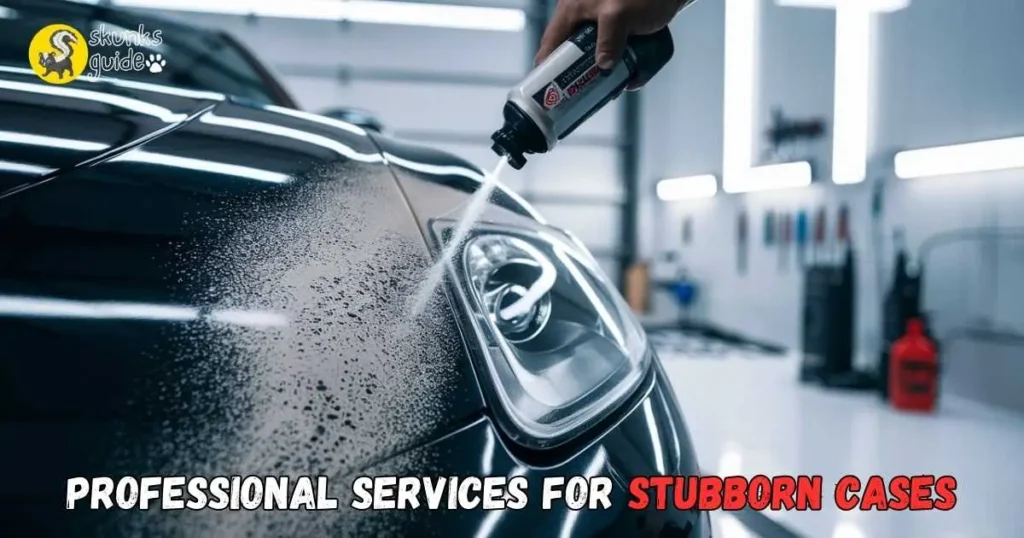
When To Call The Experts
Not all skunk spray removal is the same. Some situations require professional intervention. Here are signs it’s time to call the experts:
- Persistent Odor: The smell lingers after cleaning.
- Visible Stains: Stains remain on the paint.
- Paint Damage: The paint is chipped or damaged.
- Limited Time: You need quick results.
Cost Versus Diy
Consider the costs of professional services. DIY methods might seem cheaper. However, they can lead to further damage. Here’s a quick comparison:
| Method | Cost | Time | Risk of Damage |
|---|---|---|---|
| DIY Cleaning | $10-$50 | 1-3 hours | High |
| Professional Service | $75-$150 | 1 hour | Low |
Weigh the cost against the risk. Hiring professionals can save money long-term.
Preventive Measures For The Future
Taking steps to prevent skunk spray is key. Simple strategies can protect your car. Awareness and planning help avoid unpleasant encounters.
Skunk Repellents
Using skunk repellents can deter these animals. Choose products that are safe for your car. Here are some effective options:
- Commercial Repellents: Available at pet stores or online.
- Natural Remedies: Mix vinegar and water. Spray around your parking area.
- Essential Oils: Use peppermint or eucalyptus oil. Animals dislike strong scents.
Awareness And Avoidance Strategies
Being aware of your surroundings helps. Follow these tips to avoid skunks:
- Park in well-lit areas.
- Check for skunks before leaving your car.
- Avoid parking near trash cans.
- Keep your car clean. Remove food and wrappers.
Teach family and friends about skunk behavior. Understanding their habits can help you stay safe.
Frequently Asked Questions
What Dissolves Skunk Spray?
Baking soda, hydrogen peroxide, and dish soap effectively dissolve skunk spray. Mix one quart of hydrogen peroxide, a quarter cup of baking soda, and a teaspoon of dish soap. Apply the solution, let it sit for a few minutes, then rinse thoroughly.
This method neutralizes the odor effectively.
How Long Does It Take For Skunk Smell To Go Away On A Car?
Skunk smell can linger in a car for several days to weeks. The duration depends on factors like ventilation, temperature, and cleaning methods used. Thorough cleaning, including upholstery and air systems, can speed up the process. Regular airing out can help dissipate the odor more quickly.
How To Get Rid Of Skunk Spray Stains?
To remove skunk spray stains, mix hydrogen peroxide, baking soda, and dish soap. Apply the mixture to the stained area and let it sit for 10 minutes. Rinse thoroughly with water. Repeat if necessary. For fabrics, wash in hot water with a strong detergent.
Conclusion
Removing skunk spray from car paint is essential for maintaining your vehicle’s appearance. By following the right steps and using effective solutions, you can restore your car’s shine. Regular maintenance and quick action can prevent lasting damage. Keep your car fresh and odor-free with these simple techniques.
Your vehicle deserves the best care!

